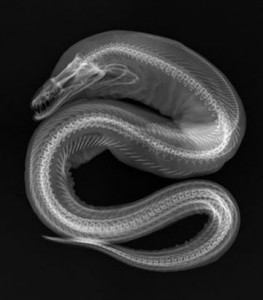“X-Ray Vision: Fish Inside Out”

Enchelynassa canina, viper moray. Moray eels are legendary predators on coral reefs. Note the second set of jaws in the “throat”; these are the gill arches, which are present in all fish. Gill arches support the gills, the major respiratory organ of fish. (Photo by Sandra Raredon)
Share the breathtaking beauty, complex biology and astonishing diversity of the ocean’s denizens from the inside out in a new exhibition at the National Museum of Natural History. “X-Ray Vision: Fish Inside Out” features the X-ray images Smithsonian scientists use to better understand Earth’s underwater ecosystems. Specimens include such marvels as the winghead shark, a pancake batfish, a bulbous deep sea angler and an ox-eyed oreo as well as the mysterious coelacanth, a prehistoric fish thought to have gone extinct alongside the dinosaurs until it was rediscovered in 1938.
A year after the first X-ray machine was invented in 1895, the new technology was already being used in the medical field. This tool is indispensable to the medical profession and archaeology, as well as many other research fields, because it helps scientists gather important information about the internal biology of the specimens they study. For example, an X-ray of a fish can illuminate essential aspects of their lives such as food preferences, growth patterns and evolutionary variations among species. Differences in habitat, size and adaptations can be observed through the skeleton, helping scientists determine how species survive in different environmental circumstances. These features are crucial in a world with increasing environmental changes.

Physopyxis lyra, Pirillo. Large, ornate pectoral spines extend from the sides of these small South American catfish. When locked in an open position, the spines prevent predators from swallowing the catfish. (Photo by Sandra Raredon)
Before the discovery of the X-ray, scientists could only obtain these insights through dissection, which took time, energy and was ultimately destructive to the specimen. X-rays give fish experts, also known as ichthyologists, a fast, easy and nondestructive way to enhance their research. All X-rays and fish photographs were taken by Sandra Raredon, museum specialist in the Division of Fishes at the Natural History Museum.
“The comparative study of fish skeletons tells the story of fish evolution and diversity,” said Lynne Parenti, curator of fishes and research scientist at the museum. “Sandra Raredon and I did this exhibition in part so that others could experience some of the beautiful and biologically complex images that Smithsonian ichthyologists and their colleagues worldwide are privileged to work with every day.”
The exhibition will be on display through Aug. 5, after which it will travel to 10 different cities as part of the Smithsonian Institution Traveling Exhibition Service before completing its tour in 2015.
For more information about the exhibition, visit the website. “X-ray Vision” may be viewed online at the Encyclopedia of Life website.
Posted: 15 February 2012



